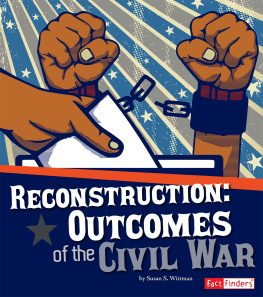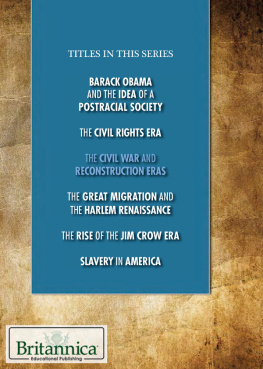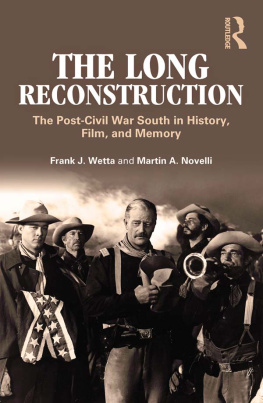SOUTH CAROLINA IN THE CIVIL WAR AND RECONSTRUCTION ERAS
SOUTH CAROLINA IN THE CIVIL WAR AND RECONSTRUCTION ERAS
Essays from the Proceedings of the South Carolina Historical Association
Edited by
Michael Brem Bonner and Fritz Hamer
The University of South Carolina Press
2016 University of South Carolina
Published by the University of South Carolina Press
Columbia, South Carolina 29208
www.sc.edu/uscpress
24 23 22 21 20 19 18 17 16
10 9 8 7 6 5 4 3 2 1
Library of Congress Cataloging-in-Publication Data
can be found at http://catalog.loc.gov/
ISBN 978-61117-664-3 (cloth)
ISBN 978-61117-665-0 (paperback)
ISBN 978-1-61117-666-7 (ebook)
FRONT COVER PHOTOGRAPHStop: Charleston 1865. Meeting Street, looking south; bottom: Francis W. Pickens (left) and General Quincy A. Gillmore (right), Internet Archive Book Images, flickr.com; Lieutenant General Wade Hampton C.S.A. (center), Wikimedia Commons
CONTENTS
Orville Vernon Burton
John B. Edmunds Jr.
Lowry P. Ware
Austin L. Venable
Roger P. Leemhuis
Christopher A. Mekow
Louis B. Towles
Frank Vandiver
James Welch Patton
Aaron W. Marrs
Patricia Dora Bonnin
Dan T. Carter
Martin Abbott
Orville Vernon Burton
Laylon Wayne Jordan
John Herbert Roper
Richard Mark Gergel
John Harold Wolfe
Robert J. Moore
Lewie Reece
Fritz Hamer
Robert J. Moore
W. Scott Poole
EDITORS NOTE

T hroughout the process of preparing this collection of outstanding articles, we have learned a great deal about editing and the technology used to assist in this endeavor. We do not consider ourselves to be experts at editing procedures and confess to have been completely unaware of the optical character recognition (OCR) process before we embarked upon this project. We worked hard to improve antiquated usages in the articles like a variety of formatting styles and different citation methods by updating then into a more uniform and up-to-date format. This was no easy task. There was a widespread problem with partial notations in the original articles. We attempted to track down all the original source materials and were successful in many cases, but some of the full citations remained elusive, despite our best efforts. For this we apologize, but the problem demonstrates the importance of consistent editing in the historical profession and the vital role of source citation in providing future generations with the ability to dig deeper into individual works of scholarship. The articles contained mistakes which we tried to correct, but we also attempted not to impose any further errors into the material. We made our best effort to rehabilitate these articles, but we also take full responsibility for any remaining errors. We hope that the benefits of bringing this impressive collection of previously little-known scholarship to a wider audience will outweigh any detractive errors in the text.
Fritz Hamer
Michael Brem Bonner
ACKNOWLEDGMENTS

O n the surface, editing projects such as this would seem straightforward. The reality is that many people are involved. As the editors we needed a way to transcribe these twenty-four articles from over eighty years of the Proceedings without having to retype each one. Todays technology is wonderful, but it required the skills and assistance of several people for us to find our way through the maze. Without cooperation from these individuals, this project would have been much harder, if not impossible. First we want to acknowledge the assistance of two colleagues at Thomas Cooper Library at the University of South Carolina. Elvin Boone, manager of Cooper Technology Lounge, led us to Bill Boland, of the Interlibrary Loan Department, who scanned all the articles. Next we are particularly indebted to William Schmidt, Jr., for converting all these scanned files to OCR text in order for us to format each article to standards that conformed to the University of South Carolina Press requirements. This step was crucial to the project, and each article took one to two hours to convert. Bill, as always, was very gracious in volunteering so much of his time in this process. We also want to thank University of South Carolina Press editor Alex Moore for his help throughout, providing guidance on press standards and reviewing each article for compatibility and consistency. Finally we also want to thank our colleagues at the South Carolina Historical Association for their enthusiastic support for the project. We trust that it will meet their expectations and that this volume will increase the visibility and readership of the organization in for the future.
INTRODUCTION

E vents in South Carolina serve as historical bookends to the era between 1860 and 1877. Historians recognize South Carolinas centrality to the Civil Wars beginning in 1861 and to the end of Reconstruction in 1877. The secession crisis of 186061 centered on fire-eating secessionists, many either in, or with direct links to, South Carolina. After Lincolns election in 1860, national attention turned to South Carolinas secession on December 20 and then to the Fort Sumter crisis. Americans on both sides of the Mason-Dixon line anxiously watched the events that culminated in the bombardment of April 12, 1861. After this dramatic episode, Civil War events in South Carolina were overshadowed by the bloody battles and campaigns in the Eastern and Western theaters. To be sure, South Carolina witnessed its share of fighting at Port Royal, Charleston, and eventually the final reckoning with Shermans March through the state in 1865, but most wartime attention was rightly focused elsewhere from 1862 to 1864.
Reconstruction in South Carolina also garnered national attention for several reasons. As Eric Foner points out, only in South Carolina did blacks come to dominate the legislative process. African American political leaders throughout Reconstruction comprised a majority of the House of Representatives, controlled its key committees, and, beginning in 1872, elected black speakers. [In 1874] blacks gained a majority in the state senate as well. In addition to famous African American national political figures like congressmen Joseph H. Rainey and Robert Smalls, Reconstruction South Carolina secured public service from two lieutenant governors, a state treasurer, and two secretaries of state, among othersall of whom were African Americans.














